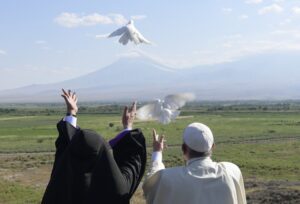VATICAN CITY (CNS) – The pontificate of Pope Francis did not result in breakthrough theological agreements with other Christians, but huge strides were made in personal relations and practical cooperation.
Pope Francis set the tone from his first public appearance as pope, repeatedly referring to himself as the bishop of Rome — an ecumenically sensitive way of referring to his office.
He kept a photograph of Orthodox Ecumenical Patriarch Bartholomew of Constantinople tucked into the blotter on his desk — a sign of their friendship and the pope’s esteem. The two met regularly, traveled together to Lesbos, Greece, to draw attention to the plight of refugees, and Pope Francis publicly acknowledged the patriarch’s long commitment to safeguarding creation and developing a theological approach to ecology in his 2015 encyclical, “Laudato Si’, On Care for Our Common Home.”

Bishop Brian Farrell, who served as secretary of the Dicastery for Promoting Christian Unity during the first 11 years of Pope Francis’ pontificate, told Catholic News Service Jan. 9, 2024, that from the very beginning the pope told him and Cardinal Kurt Koch, dicastery prefect, “If there’s something we have to do, tell me and we’ll do it.”
For Pope Francis, he said, “it’s the doing.”
“And this was synthesized in the words he constantly used: walking together, praying together, working together,” Bishop Farrell said. “In other words, he was saying we can’t wait to solve all the theological questions. We must walk together now.”
Pope Francis’ personality and ease in building a rapport ensured those journeys happened – spiritually and literally.
Not only did he visit migrants in Lesbos with Patriarch Bartholomew, but he made an ecumenical peace pilgrimage to South Sudan in 2023 with Anglican Archbishop Justin Welby of Canterbury and the Rev. Iain Greenshields, moderator of the Church of Scotland, a Presbyterian church. The three leaders went not only to encourage political leaders to get serious about making peace, but also to help revive local ecumenical relations as a voice for the people demanding peace and reconciliation.
Pope Francis had “an ability to deal with people as they are,” Bishop Farrell said, and he never made them feel that he was above them.
He could be blunt, however.
Less than a month after Russia’s full-scale invasion of Ukraine in 2022, an invasion supported by Russian Orthodox Patriarch Kirill of Moscow, Pope Francis had a video call with the patriarch.
“I spoke with Kirill for 40 minutes via Zoom. He spent the first 20 minutes holding a piece of paper reading all the reasons for the war,” the pope later said in an interview. “I listened to him, and I told him, ‘I don’t know anything about this. Brother, we are not clerics of the state, we cannot use the language of politics, but of Jesus. We are shepherds of the same holy people of God. That is why we must seek the path of peace, to cease the blast of weapons.'”
The pope added in the interview: “The patriarch cannot turn himself into Putin’s altar boy.”
The Catholic Church’s relationship with the Russian Orthodox Church had been fraught for decades, so it was hailed as a major breakthrough when, in 2016, Pope Francis and Patriarch Kirill became the first pope and Russian patriarch to meet in person. Their encounter took place at the airport in Havana, Cuba, as the patriarch was making a pastoral visit and the pope was on his way to Mexico.
Throughout his pontificate, Pope Francis spoke of the “ecumenism of blood” — the Christian unity seen sadly and powerfully in Christians who were killed for their faith in Jesus with absolutely no concern about the denomination to which they belonged.
In May 2023, welcoming Coptic Orthodox Pope Tawadros II of Alexandria, Egypt, to the Vatican, Pope Francis announced he was adding to the Catholic calendar of saints the 21 Coptic martyrs whose 2015 murders on a beach in Libya by Islamic State fighters shocked the world.
The pope said including the Coptic martyrs in the Roman Martyrology, the book-length calendar of saints’ feast days, was “a sign of the spiritual communion that unites our two churches.”
“This is a first,” Bishop Farrell said at the time. During ecumenical meetings and prayer services, he said, it is common to “commemorate informally” saints and martyrs of another tradition, “but there never has been a decision to put them into the martyrology,” thus formally including them “in the prayer of our church.”
While encounters with other Christian leaders were a standard agenda item when Pope Francis traveled abroad, two of his trips were focused specifically on ecumenical relations: in late 2016, he flew to Lund, Sweden, to launch with leaders of the Lutheran World Federation a year of activities to mark the 500th anniversary of Martin Luther’s efforts to reform the church; and in June 2018 he traveled to Geneva, Switzerland, to visit the World Council of Churches.
Pope Francis’ pontificate also included more private ecumenical moments, including having Patriarch Bartholomew, Archbishop Welby and other church leaders stay in his residence, the Domus Sanctae Marthae, when they were in Rome.
The hospitality was reciprocated, too. When he went to Armenia in 2016, the pope was the house guest of Catholicos Karekin II, the patriarch of the Armenian Apostolic Church. After a papal Mass in Yerevan, which the catholicos attended, Pope Francis invited him to join him in the popemobile. The two leaders gave the crowds their blessings.
